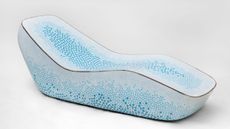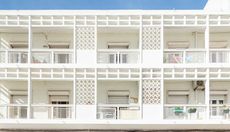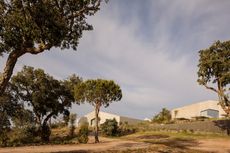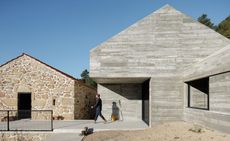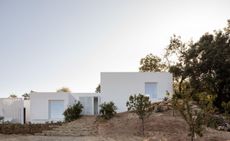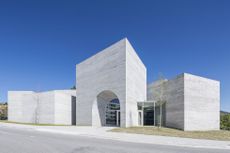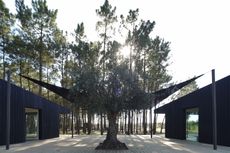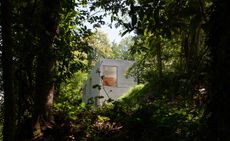Lisbon Architecture Triennale 2022 offers a fresh exploration of Earth
We explore the offerings of Lisbon Architecture Triennale 2022, and its theme ‘Terra'
- (opens in new tab)
- (opens in new tab)
- (opens in new tab)
- Sign up to our newsletter Newsletter
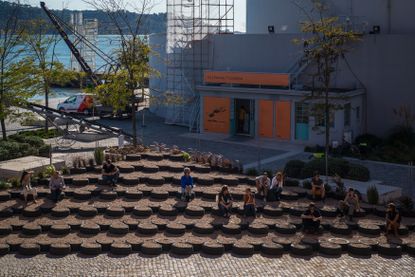
‘The Poetics of Reason’ was the rather lofty topic of the festival's 2019 edition, but for Lisbon Architecture Triennale 2022, the two-month-long architecture event takes on a theme that is, quite literally, more down to earth: ‘Terra’. Through four major exhibitions, three days’ worth of conferences, and an array of independent projects chief-curated by Cristina Veríssimo and Diogo Burnay, Terra explores how we can change the grim trajectory of our home planet which, according to triennial chairman José Mateus, has ‘reached a dead end that we can hardly get out of'.
‘In an ideal world, this would be an age with enormous potential, except human activities have been dictated by high levels of ignorance for a long time, together with extremely high degrees of negligence and greed,' Mateus added. ‘All of this is based on a belief which is irresponsible, to say the least: that the Earth absorbs everything.'

‘Multiplicity’ includes displays around the project Bookworm Pavillion in India.
Visitors are immediately confronted with the consequences of their environmental wrongdoings at the ‘Retroactive’ exhibition in Lisbon’s MAAT museum, which begins by projecting video footage of engorged landfills, extreme weather incidents and overcrowded infrastructures in what’s termed ‘broken cities' across the globe.
The projects presented throughout the following rooms do, however, prove that steps are being taken to bolster urban habitats and their outskirts; this includes Tapis Rouge by Eva Studio, a community amphitheatre built at the heart of Haiti’s Carrefour-Feuilles suburb that – thanks to an underground dry well – doubles up as a flood mitigation system. There’s also Estudio Teddy Cruz and Fonna Forman’s El Santuario Frontera project, which sees metal storage racks repurposed to create the framework of housing for refugees at the Tijuana-San Diego border.

Display in the ‘Cycles’ exhibition.
The ‘Cycles’ exhibition over at Lisbon’s Garagem Sul cultural centre offers a look at the different ways architects and other creatives are making use of recovered construction materials, from concrete to cork – nearly 140 cubic metres of the latter (which was once used for building insulation) sits in a towering pile at the rear of the main gallery space as part of an installation titled Falca. It’s the work of conceptual artist Lara Almarcegui, who compels audiences to consider the startling volume of materials required to realise our sprawling built environment.
Visitors will also no doubt be inspired by the projects shown at the ‘Multiplicity’ exhibition in Lisbon’s National Museum of Contemporary Art; from a community fridge in New York, to friendship benches in Zimbabwe, and a modular reading pavilion in Mumbai, it's clear that even smaller-scale projects are capable of solving major social and eco challenges.

View of installation at ‘Visionaries’ by Culturgest
While a majority of what’s showcased in the 2022 Lisbon Triennial acts as a rousing call to action in the fight against climate change, some of the works presented are interestingly more of a call-to-withdraw. In Culturgest’s ‘Visionaries’ exhibition, for example, Ensamble Studio makes a case for off-grid living with Ca’n Terra House – a family dwelling that occupies a cave-like Menorcan sandstone quarry. Then over at the independent projects show in Lisbon’s Palácio Sinel de Cordes, Plan B Architecture & Urbanism’s ‘Terra Infirma – Terra Incognita’ project proposes establishing universal no-fly zones and points of inaccessibility.
In the process, humans could ‘retire their status as a truly global species' and allow once-unknown parts of the Earth to recover from our harmful practices – and with the unquestionable urgency of the climate crisis, perhaps we should indeed ready ourselves to retreat.

‘Visionaries’ by Culturgest.

Part of the event’s Independent Projects at Palacio Sinel de Cordes.
INFORMATION
trienaldelisboa.com (opens in new tab)
-
 Men’s engagement rings for modern grooms
Men’s engagement rings for modern groomsMen’s engagement rings, whether classic or colourful, make for sentimental tokens
By Hannah Silver • Published
-
 Longchamp unites with D’heygere on a playful collection made to ‘transform the everyday’
Longchamp unites with D’heygere on a playful collection made to ‘transform the everyday’Inspired by Longchamp’s foldaway ‘Le Pliage’ bag, this collaboration with Paris-based jewellery and accessories designer Stéphanie D’heygere sees pieces that ‘transform and adapt’ to their wearer
By Jack Moss • Published
-
 Last chance to see: Marc Newson’s all-blue designs in Athens
Last chance to see: Marc Newson’s all-blue designs in AthensGagosian gallery Athens presents new blue furniture and objects by Marc Newson
By Rosa Bertoli • Published
-
 Roll up! It‘s the Faro Modernist Weekend’s inaugural edition
Roll up! It‘s the Faro Modernist Weekend’s inaugural editionFaro Modernist Weekend, a festival dedicated to mid-century architectural delights in the Portugal’s Algarve, has just launched its first iteration
By Stacy Suaya • Last updated
-
 Pa.te.os hotel in Portugal is a concrete love affair with Alentejo
Pa.te.os hotel in Portugal is a concrete love affair with AlentejoPa.te.os hotel by Aires Mateus is set in the Alentejo landscape in Portugal and celebrates the blend of concrete and nature
By Jessica Rose • Last updated
-
 This Portuguese farmhouse takes its cues from its natural surrounds
This Portuguese farmhouse takes its cues from its natural surroundsNaMora House is a Portuguese farmhouse by architects Filipe Pina and David Bilo that opens a dialogue with its leafy surrounds
By Ellie Stathaki • Last updated
-
 Globalisation, urbanity, the pandemic and more explored at MAAT Lisbon show
Globalisation, urbanity, the pandemic and more explored at MAAT Lisbon showA new exhibition at MAAT Lisbon, ‘X is Not a Small Country – Unravelling the Post-Global Era’, curated by Aric Chen with Martina Muzi, explores globalisation, urbanity, the pandemic and more
By Ellie Stathaki • Last updated
-
 Casa Um gives pause for thought in the Algarve with minimalist redesign
Casa Um gives pause for thought in the Algarve with minimalist redesignA redesigned rural Portuguese home becomes a humble yet modern rertreat, a minimalist house by local architecture collective Atelier Rua
By Ellie Stathaki • Last updated
-
 Porto’s modern architecture is having a moment
Porto’s modern architecture is having a momentBy Dario Goodwin • Last updated
-
 Comporta cabins: sustainable breaks for escape artists
Comporta cabins: sustainable breaks for escape artistsReferencing traditional fishermen huts, Studio 3a worked with the bare essentials
By Ellie Stathaki • Last updated
-
 Porto-based studio Pablo Pita designs a modest retreat near the Douro River
Porto-based studio Pablo Pita designs a modest retreat near the Douro RiverBy Harriet Thorpe • Last updated


